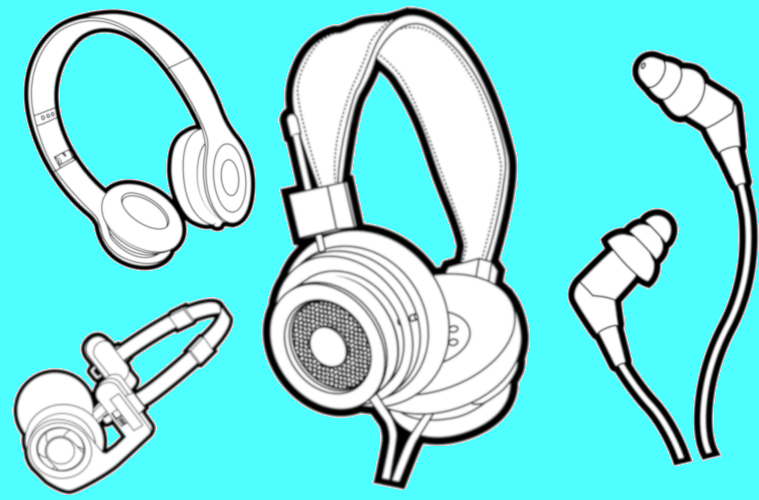The line between consumer and professional audio products seems to blur more and more with each passing year. In response to the high standards of audiophiles, in addition to the demands of gigging musicians, part-time DJs and shadetree audio engineers, many manufacturers now offer professional-grade audio equipment priced for pro-am users. And, as technology continues to advance and prices continue to drop, this professional-grade equipment has become more accessible than ever for everyday consumers.
Thanks to this influx of potential customers, the high-end headphone and in-ear monitor (IEM) market has seen continued growth over the past several years, and it is poised to continue growing into the foreseeable future. Headphone sales revenues in the United States alone are projected to total approximately $3.9 million for 2018, according to Statista. And, according to Business Insider, the global earphone and headphone market is expected to see a compound annual growth rate (CAGR) of 7.31% for the years 2017 to 2023.
Clearly, there is money to be made in headphones and in-ear monitors, and manufacturers are eager to cash in. For example, Apple has been a major player in the headphone category since its acquisition of Beats Electronics and its ubiquitous colorful cans back in 2014, but the company will reportedly release a line of Apple-branded over-the-ear headphones, as well as a waterproof “pro” version of its in-ear Air-Pods, in 2019. Likewise, none other than Dwayne “The Rock” Johnson recently revealed that he is entering the high-end headphone market in collaboration with JBL and Under Armour. And, of course, established legacy pro-audio brands have been expanding their offerings and adopting new technologies in response to the widening market for headphones and in-ear monitors.
This widening of the market has led to a stratification of the market, as well. Manufacturers are offering solutions designed for just about every conceivable application, with different models priced for every level of user. There are custom solutions that involve crafting headphones or in-ear monitors specifically for the ears of an individual user, as well as one-size-fits-all options. And there are several additional features to choose from, including wired or wireless connectivity, noise-canceling and 3D audio technology, and waterproof and ruggedized construction, to name a few.
With so many options for so many different users available, it can be hard for retailers to determine which products to stock in their stores. With that in mind, the Music & Sound Retailer talked to a number of manufacturers of high-end headphones and in-ear monitors about the current state of the market, the features and functions that matter to different users, and what the future holds for this hot product category. Respondents are Luca Bolognesi, vice president of marketing for V-Moda; Alan Cabasso, CEO of SECA Group and marketing coordinator for Floyd Rose Audio; Nithin Cherian, product marketing manager for Yamaha Pro Audio; Philippe Depallens, vice president and general manager of Ultimate Ears; Matt Engstrom, senior category director for Shure; Justin Norvell, senior vice president of Fender products at Fender; and Glenn Roop, vice president of business development for CAD Audio.

‘Casual listeners have been influenced by the heavy marketing investments of big brands pushing [active noise canceling]. However, there are features which have always been important and will always be important for casual listeners and professionals alike. These features are sound quality, the durability of the products, choice of materials and design. These four pillars are here to stay, regardless of where technology takes headphones in the future.’ Luca Bolognesi, vice president of marketing, V-Moda
Market Watch
All respondents were universally positive about the relative health of the headphone/IEM market and its potential for future growth. “The market for high-end headphones/in-ear monitors is healthier than it’s ever been. Headphone sales surpassed desktop PC sales in America in 2017, becoming the fourth best-selling category in consumer electronics, excluding mobile phones,” said Bolognesi, citing research from the NPD Group. “The average selling price is increasing thanks to Bluetooth products, new technology and novelty subcategories entering the market.”
Cherian also pointed to increased sales over 2017 at Yamaha. “The markets are as strong as ever. Our professional over-ear models, such as our HPH-MT8 headphones and others in that line, have been selling well; sales are up over last year,” he said.
Respondents whose brands are newer to the headphone/IEM category shared that, while their brands are making headway in the United States, they have seen more early adoption in foreign markets. “We do a lot of business in the European market — a little bit more than the USA market,” said Cabasso. “The USA is still trying to figure out that, while Floyd Rose makes instruments, they also make headphones.”
According to Norvell, “Globally, the high-end headphone and in-ear market is a very unique space. It’s a new, exciting segment for [Fender,] and we see a great growth potential across the global market. In the U.S., you are dealing with audio engineers, musicians and some audiophiles, but our largest market is in Asia with high-end audiophile customers centralized in Hong Kong. We are new to this space and very excited by the early results.”
While Depallens was optimistic about the strength of the IEM market itself, he also pointed to the importance of the accessories market and the greater pro-audio ecosystem for continued adoption of IEMs, particularly among professional users. “The market adoption of in-ear monitors has been increasing steadily, but there is still more room for growth,” he explained. “Many still perceive in-ear monitors as tools for musicians playing large arenas, when in reality they are tools for anyone who takes their craft seriously and wants to take their performance to the next level. In the past, getting in-ears required significant investment beyond just the in-ears. Two years ago, we introduced the Ultimate Ears Sound Tap, which allows anyone to plug into the onstage sound mix and use in-ears. Our hope is that there will be more innovation around the stage ecosystem, so more people can access in-ear monitors and protect their ears during performances. The more the ecosystem accommodates in-ear monitors, the more growth is possible.”

‘The pros and aspiring pros that use our headphones do so for applications that generally don’t require them to move around much, so adding an additional layer of technology to include wireless features that they’re not likely to use is not worth the risk of increasing latency with the added complexity.’ Nithin Cherian, product marketing manager, Yamaha Pro Audio
Tech Trends
The respondents pointed to a number of technology trends dominating the headphone and IEM market. Chief among these were wireless Bluetooth technology, enhancements meant to increase portability and ease of use, and noise-cancelling effects. But, of course, sound quality, comfort and durability are still of the utmost importance to professional and casual users of all levels of expertise.
“Two big trends have shaken the industry in the past 18 months: active noise canceling (ANC) and ‘true wireless,’ which quickly became prominent with Apple’s AirPods,” said Bolognesi. “Both these trends, however, come with compromises, and they are not the best choice for every user. In fact, ANC actually pollutes the sound and relies on EQ vs. analog tuning. It’s still early days for ‘true wireless’ technology, as it currently compromises the stability of the Bluetooth connection (causing dropouts), battery life and, of course, sound quality, with the drivers being so small in order to give space to the electronics.”
He added, “Casual listeners have been influenced by the heavy marketing investments of big brands pushing ANC. However, there are features which have always been important and will always be important for casual listeners and professionals alike. These features are sound quality, the durability of the products, choice of materials and design. These four pillars are here to stay, regardless of where technology takes headphones in the future.”
Bolognesi also explained that wireless technology has progressed to the point that the loss in sound quality and increase in latency typically associated with wireless is not as impactful as it once was. “The compromise of sound quality for wireless technology used to be very true in the past. For this reason, V Moda didn’t release a Bluetooth headphone until late 2015,” he said. “However, we have been able to shift the paradigm with our Crossfade Wireless series, creating a headphone which is analog first, with Bluetooth added for convenience. Since 2014, wireless tech has made a huge leap in sound quality and has made huge improvements with the introduction of high-resolution Bluetooth audio codecs such as Qualcomm aptX. In our most recent Crossfade 2 Wireless Codex Edition, launched on June 6, we added aptX along with AAC and SBC for universal Bluetooth compatibility with any device and to provide the best possible wireless experience. We can proudly say that our Bluetooth sound is virtually indistinguishable from the sound in analog mode.”

‘When we’re talking about professionals — recording producers, remix guys, DJs — the headphones have to have good-quality sound, they’ve got to be lightweight and comfortable. That’s the most important thing, really. Everybody, when they pick up a pair of headphones, they check to see if it’s too heavy. You want a guy sitting in his studio for four or five hours with headphones on to go “Wow, I forgot they’re on my head.”‘ Alan Cabasso, CEO, SECA Group/marketing coordinator, Floyd Rose Audio
Engstrom likewise expressed excitement at how recent advances in wireless have opened new opportunities to enhance the listening experience through the use of apps and other software. “Wireless connectivity meant merely fewer wires until just a few years ago. Now we are seeing greater functionality over wireless connections via apps that enhance the user experience,” he explained. “The convenience of wireless has always been sought after, and we are finally at a point where technology meets the needs of the wireless user. There are several wireless codecs now available which boast a high enough sound quality that they can be taken seriously by both professional and audiophile customers.”
Engstrom also pointed to the growing public demand for noise-canceling technology, in addition to higher-quality wireless connections. “Higher-resolution Bluetooth quality and more effective noise-canceling properties have become more important for high-end headphone consumers,” he declared. “Great sound quality and comfort have always been required, but now more than ever, top wireless and noise-canceling technology are necessary.”
Norvell identified some hot technology trends, but he also stressed that the stratification of the market makes it all but impossible to offer a list of functions that will please all users. “True wireless is the big technology trend and artificial intelligence is the other. As technology evolves, it’s not for everybody, and if there’s one thing that you can say about the marketplace today it’s that it is extraordinarily fragmented,” he described. “The continuum of customer needs goes from the most discriminating audiophiles down to people who want to jog and listen to music at the same time. People want products that perform well and relate to their specific needs. It’s not a one-size-fits-all world anymore. Your average music-loving consumer is not expecting the same performance as somebody who’s on stage or that’s running the monitors for a concert. Everybody has a specific, unique need and they are looking for a specific, unique solution.” According to Norvell, flashy new tech like wireless functionality is less important to audiophiles who simply want the best possible sound quality. “For some customers, the extraordinary high-fidelity performance is what they are after. They don’t need wireless function,” he asserted.
Cherian noted that customer feedback has led to innovations in ease of use and portability. “For over ear headphones, customers have consistently wanted something collapsible with detachable cables,” he said. “This allows for both portability and the ability to easily replace a cable in the field.”

‘Audiophiles, by nature, are more willing to pay a higher price. Because they want more and expect more, they understand that it takes higher-end components and more complex workmanship to obtain that quality. Some of these customers also spend $10,000 on speakers, amps and super high-end audio sources. Because in-ears are performance enhancers and not required to play an instrument, musicians are typically more price sensitive. It’s more of a tool, so just like any other craftsman, musicians start at entry level and slowly progress.’ Philippe Depallens, vice president and general manager, Ultimate Ears
Depallens also described how his company redesigned its IEMs with ease of use and durability in mind in response to user feedback. “We’ve spent a great deal of time researching ways to improve reliability, and we’ve found that the cable connection point is typically where failure happens the most,” he explained. “To address this industry-wide issue, we co-developed a new cable and connection system, the Ultimate Ears IPX Connection System, which now comes on all of our custom in-ear monitors. It’s designed to minimize the need for service and maintenance, because it can withstand the rigors of music touring: sweat, makeup, hairspray, humidity, set up, break down and travel.”
While prioritizing audio fidelity, portability, and ease of use seems to be a winning recipe for attracting customers, some manufacturers have also begun incorporating more experimental technologies in their products in an attempt to stand out from the pack. For example, Floyd Rose Audio plans to release over the-ear and in-ear models that feature 3D technology in the near future. “For our new series that’s coming out in the next couple of months, we’ve designed a 3D headphone. It’s got divider frequency boards built into each ear cup, with two speakers in each cup and two sound coils instead of one,” Cabasso described. “The sound is unique. It’s different. When you have them on your head, it’s like you’re sitting in the middle of the room and an orchestra is surrounding your body. And we also have a 3D earbud coming out that uses the same technology.”
Pros Vs. Joes
Certain features and functions are equally appealing to both casual and professional consumers of headphones and IEMs, but there are also some areas of disagreement.
For example, although wireless Bluetooth technology is currently all the rage among casual users, it still isn’t a top priority for professionals. “The pros and aspiring pros that use our headphones do so for applications that generally don’t require them to move around much, so adding an additional layer of technology to include wireless features that they’re not likely to use is not worth the risk of increasing latency with the added complexity,” said Cherian.
According to Depallens, while musicians would enjoy the convenience of wireless in their IEMs, the technology just isn’t ready for showtime just yet. “The technology must be extremely reliable, and with the bare minimum amount of latency. Musicians are extremely sensitive to very short latency, and even a small amount of latency can throw off a performance. The current wireless standards, like Bluetooth, are not yet ready for stage use.”
He added, “But for non-musicians, there is more and more interest in Bluetooth. The ability to connect to smart devices without a cord is growing rapidly (especially with the removal of the popular 3.5mm jack). Convenience, most of the time, wins over quality. Even though Bluetooth may affect the intended performance of the in-ear monitor, the listener still has great sound quality and isolation, while getting to cut the cord. For most, the tradeoff is acceptable.”

‘Wireless connectivity meant merely fewer wires until just a few years ago. Now we are seeing greater functionality over wireless connections via apps that enhance the user experience. The convenience of wireless has always been sought after, and we are finally at a point where technology meets the needs of the wireless user. There are several wireless codecs now available which boast a high-enough sound quality that they can be taken seriously by both professional and audiophile customers.’ Matt Engstrom, senior category director, Shure
The most commonly cited difference between professional and casual users was the utilitarian emphasis on comfort and usability among pros. “When we’re talking about professionals — recording producers, remix guys, DJs — the headphones have to have good-quality sound, but besides the sound, they’ve got to be lightweight and comfortable,” said Cabasso. “That’s the most important thing, really. Everybody, when they pick up a pair of headphones, they check to see if it’s too heavy. You want a guy sitting in his studio for four or five hours with headphones on to go ‘Wow, I forgot they’re on my head.’”
Cherian agreed that professional users are primarily concerned with finding comfortable headphones and IEMs that are suited to the specific task at hand, while non-professional users are more attracted to aesthetics and trendy tech. “Headphones can have many applications in the professional market, and pro users tend to choose headphones according to the task they need to approach,” he said. “For tracking purposes, to take one example, they need to isolate the outside noise, be loud enough that the wearer can focus on his or her performance, and minimize bleed outside the headphones. Other times you choose headphones based on how comfortable they feel over long periods of time; you don’t want to have to worry about comfort while monitoringaudio without breaks for an hours-long job like a sporting event, awards show, etc. Casual or recreational users, on the other hand, tend to prioritize the aesthetics of the headphones themselves, as well as the benefits of wireless capacity.”
Engstrom asserted that accurate sonic reproduction and durability are the most important factors for both professional and casual users, although he agreed that casuals are also drawn to aesthetics. “Musicians require accurate, balanced audio quality and rugged, reliable design. These attributes are appreciated by casual listeners, but they will also have a preference on things like color and extra features, where musicians usually tend to leave out the unnecessary features,” he said. Engstrom also pointed out that, while many manufacturers offer headphones and IEMs with drivers that emphasize a particular range of sounds, these solutions are likely to appeal more to casual listeners. “Musicians tend to prefer a more balanced sound — one that reflects the sound of the input, whatever instrument that is,” he said. “Casual listeners sometimes prefer a more tailored sound quality with an emphasis in a particular frequency range.”
Norvell emphasized that many professionals use their equipment in active, demanding environments where reliability and durability are paramount. “The stage can be a very dynamic environment,” he declared. “For musicians, in-ear monitors have to perform on stage with the same reliability as a sport-type device. They need to be durable and reliable.”

‘The continuum of customer needs goes from the most discriminating audiophiles down to people who want to jog and listen to music at the same time. People want products that perform well and relate to their specific needs. It’s not a one-size-fits-all world anymore. Your average music-loving consumer is not expecting the same performance as somebody who’s on stage or that’s running the monitors for a concert. Everybody has a specific, unique need and they are looking for a specific, unique solution.’ Justin Norvell, senior vice president of Fender products, Fender
Price point is, of course, another differentiator for casual users and professionals. Professionals are willing to pay more for quality and reliability, while casual listeners tend to be the most sensitive about price. According to Roop, price point is a reflection of the performance of the solution, and professional users recognize this. “Price points follow performance. Generally, a musician will require higher performance than a casual listener,” he said. “Casual listeners tend to respond to marketing efforts rather than performance. Conversely, musicians are a more informed buyer and require proven value; they recognize design and performance characteristics.”
Somewhat surprisingly, many of the respondents suggested that non-professional audiophile listeners are willing to pay the most for their headphones and IEMs. “In our experience, the most demanding, critical user that’s willing to pay the most money is an audiophile; they want custom fit and custom design, and that’s regularly offered in the $2,000-plus range,” Norvell said. “The next-least-expensive offering will be for audio engineers, monitor and front-of-house professionals, and of course, performers. Non-musicians follow with the most affordable pricing.”
Depallens echoed this assessment. “Audiophiles, by nature, are more willing to pay a higher price. Because they want more and expect more, they understand that it takes higher-end components and more complex workmanship to obtain that quality. Some of these customers also spend $10,000 on speakers, amps and super-high-end audio sources,” he explained. “Because in-ears are performance enhancers and not required to play an instrument, musicians are typically more price sensitive. It’s more of a tool, so just like any other craftsman, musicians start at entry level and slowly progress.”

‘Price points follow performance. Generally, a musician will require higher performance than a casual listener. Casual listeners tend to respond to marketing efforts rather than performance. Conversely, musicians are a more informed buyer and require proven value; they recognize design and performance characteristics.’ Glenn Roop, vice president of business development, CAD Audio
Bolognesi also supported the claim that non-musicians are willing to pay the most for the right product, but he also suggested that, while musicians of different experience levels used to have different pricing expectations, those days may be done. “Casual listeners are currently willing to pay premium price tags when headphones feature the ‘latest and greatest’ in technology, or at least what consumers perceive that is,” he said. “Musicians were once divided into two groups: beginners and professionals. The beginners, or casual musicians, considered headphones as the last accessory to buy after the rest of the equipment had been acquired. On the other hand, highly skilled and professional musicians always understood that a great headphone could make a big difference to their entire setup and this was never something to be compromised. With headphones becoming increasingly popular however, the difference between the two categories is being blurred, and overall, the [average selling price] musicians are willing to spend for their headphones is increasing.”
The Changing Market
To conclude our discussion, the Retailer asked our respondents for their take on heavy-hitters like Apple getting more involved in the headphone and in-ear market in 2019. Everyone seemed to agree that, when it comes to competition, the more the merrier.
“When a major player excites a category, it’s always good for the players in that category,” Roop said. “An excited market is a fruitful market.”
“When Apple decides to enter a category, they look past the short-term ‘flash-in-the-pan’ buzz features and instead focus on having a long-term lasting impact,” Engstrom said. “Apple wasn’t the first to do discrete wireless — we first saw a lot of these features a decade ago (charging cases, smart controls integrated into each side, etc.). But, with AirPods, Apple made the first affordable, dependable and very easy to use/pair/charge set of truly wireless earphones. I’d expect no less if they were to enter the headphone market.”
“Apple AirPods have already created an earthquake effect in the headphone market, so I would expect something similar to happen with an Apple-branded over-the-ear headphone,” Bolognesi predicted. “However, if big brands like Apple enter into the market focusing on technology, it’s good for the competition and ultimately for the consumers. As a brand, we are always challenged to push the envelope and fulfill the needs of our customers. Competition fuels innovation in the headphone market, just like in any other industry.”


